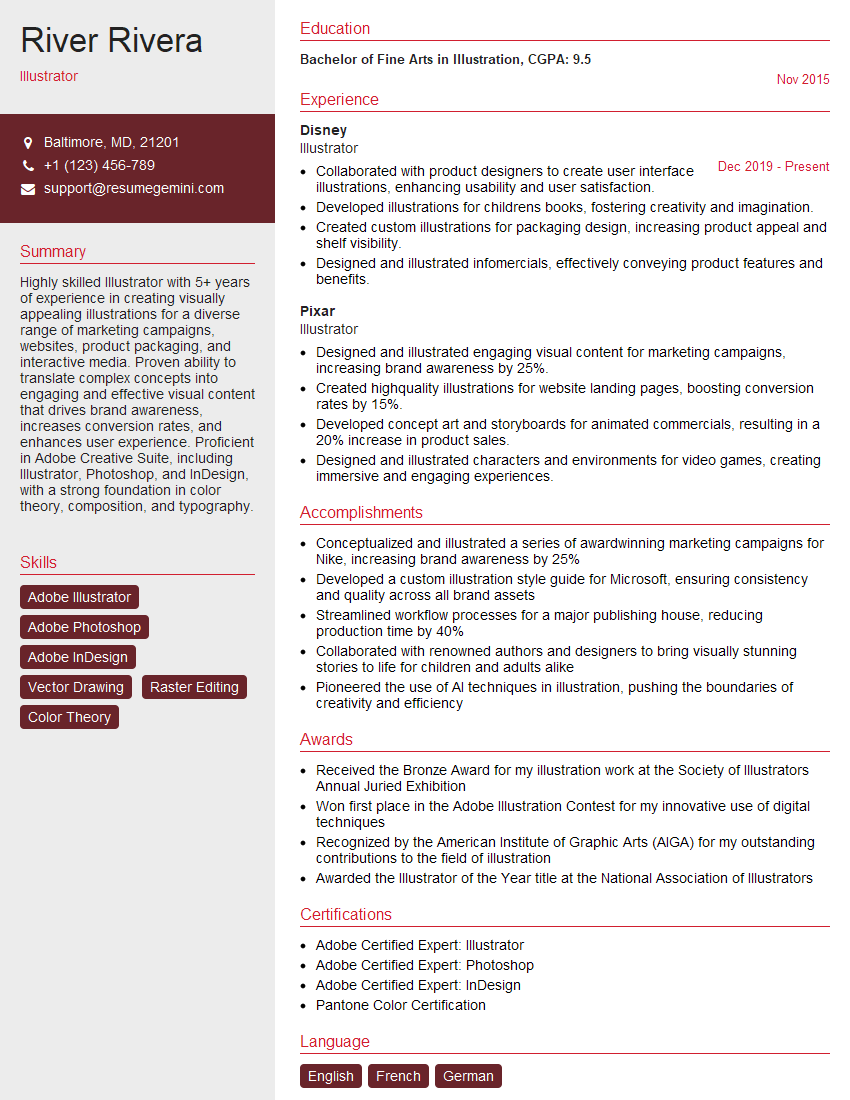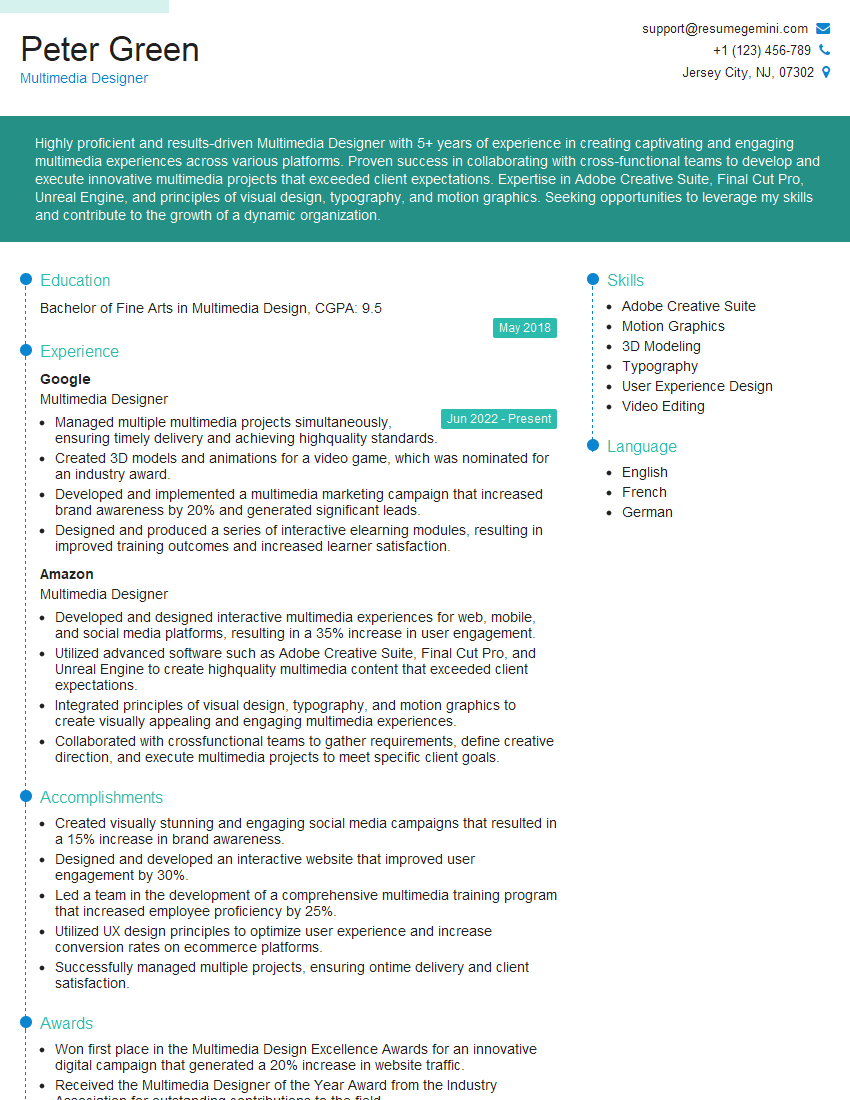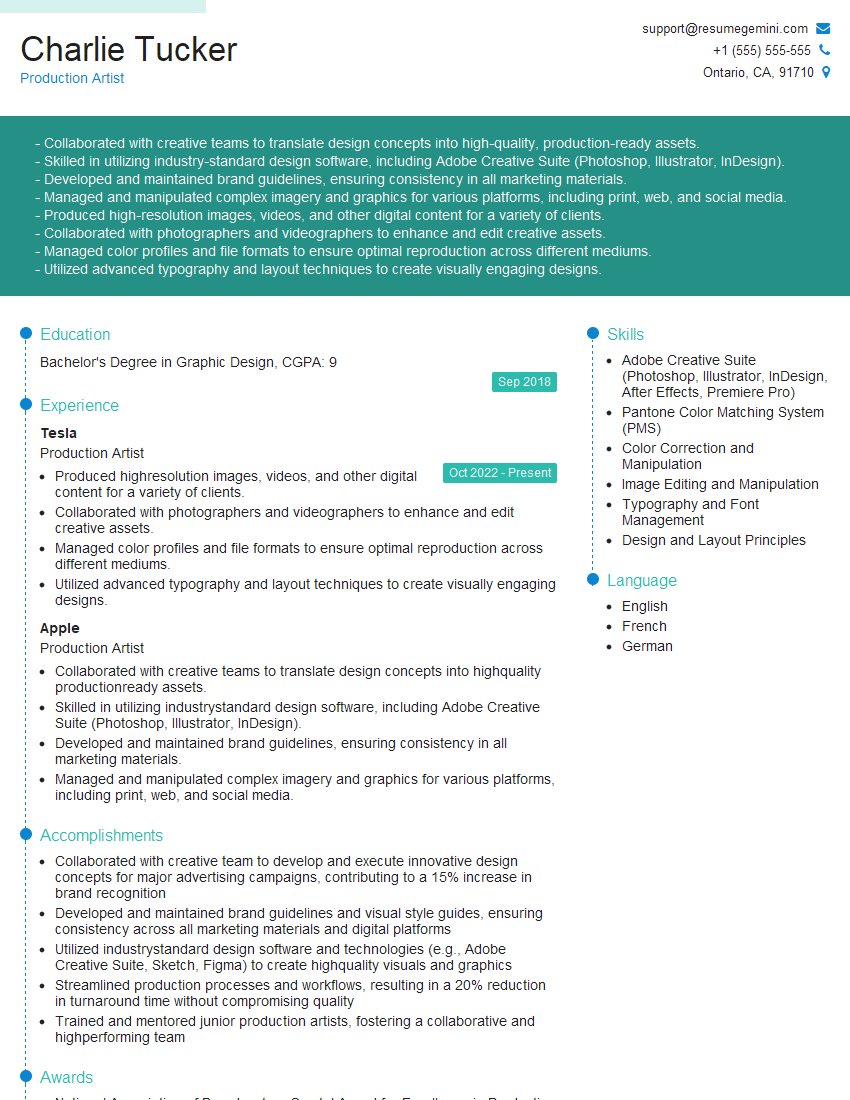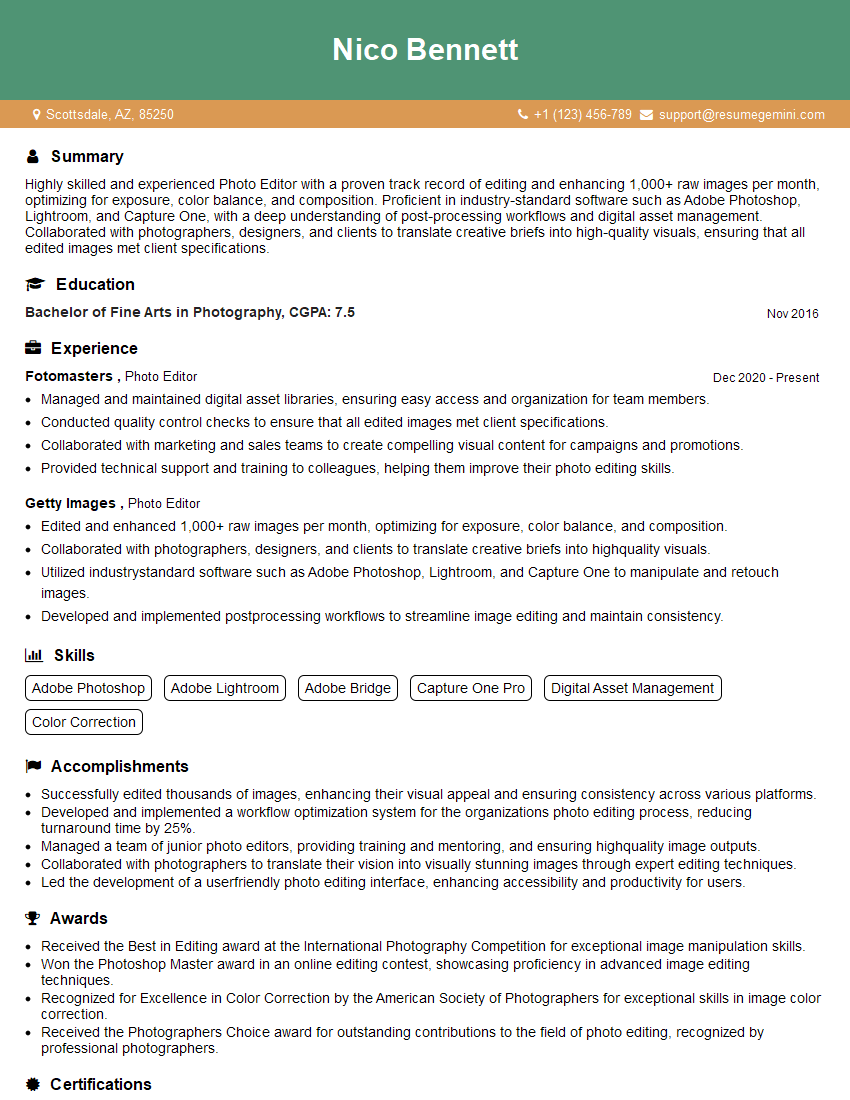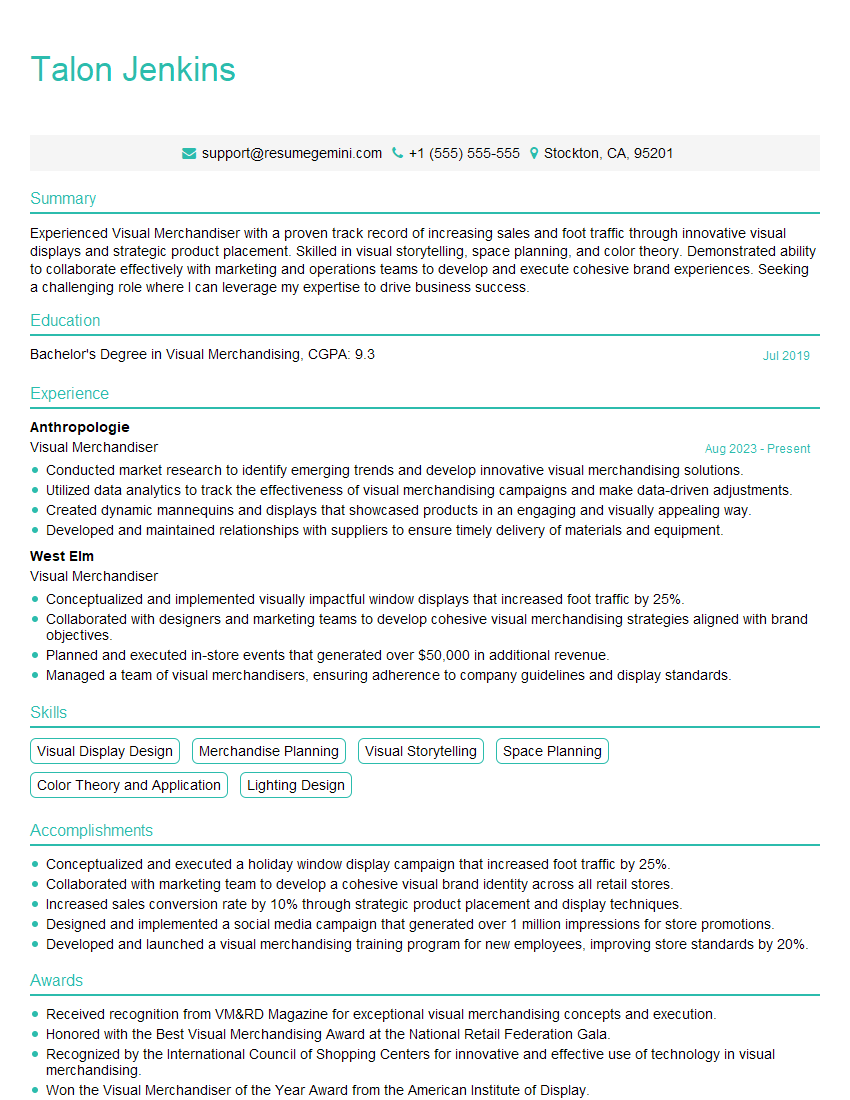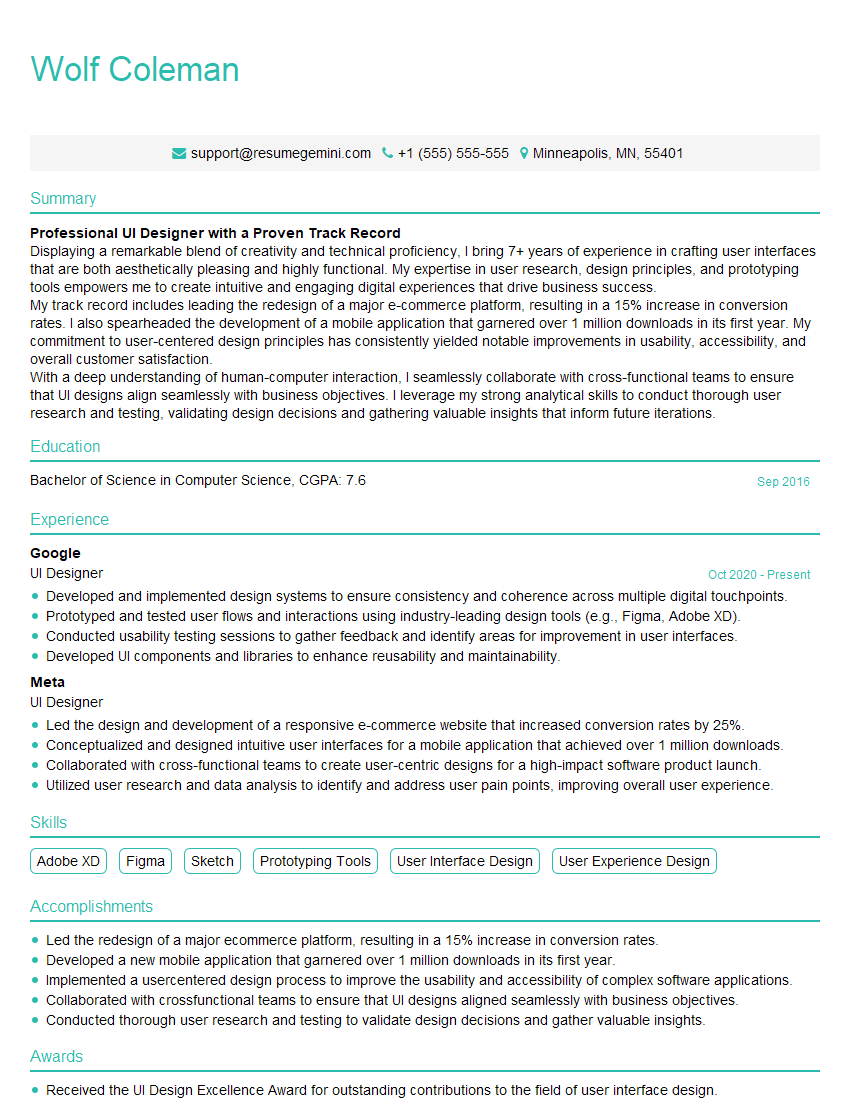The thought of an interview can be nerve-wracking, but the right preparation can make all the difference. Explore this comprehensive guide to Ability to create and manage visual assets interview questions and gain the confidence you need to showcase your abilities and secure the role.
Questions Asked in Ability to create and manage visual assets Interview
Q 1. What file formats are best for web and print design, and why?
Choosing the right file format is crucial for both web and print design, as it directly impacts file size, image quality, and compatibility. For web design, you want formats that balance image quality with small file sizes for faster loading times. For print, you prioritize high resolution and color accuracy for professional-quality output.
- Web:
- JPEG (.jpg): Best for photographic images. Offers good compression, resulting in smaller file sizes, but can cause some loss of image quality. It’s a great choice for photos on websites and social media.
- PNG (.png): Ideal for images with sharp lines, text, or logos. Supports lossless compression, preserving image quality. PNGs are excellent for graphics with transparent backgrounds, making them versatile for web design elements.
- WebP (.webp): A newer format offering superior compression compared to JPEG and PNG, resulting in smaller file sizes and better image quality. It’s gaining popularity but browser support is still evolving.
- SVG (.svg): Uses vector graphics, meaning the image quality doesn’t degrade when scaled. Perfect for logos, icons, and illustrations that need to be resized without losing detail. These are increasingly favored for responsive web design.
- Print:
- TIFF (.tiff): Lossless compression, ideal for high-resolution images and pre-press workflows. Offers excellent color accuracy, crucial for print projects requiring fine detail.
- PDF (.pdf): A versatile format suitable for both images and text. It’s great for distributing print-ready designs that need to maintain their visual integrity across different platforms.
In summary, the choice depends on the specific needs of the project. For a website, consider a combination of JPEG for photos, PNG for graphics, and SVG for scalable elements. For print, TIFF or high-resolution PDF is generally preferred.
Q 2. Describe your experience with Adobe Creative Suite (Photoshop, Illustrator, InDesign).
I have extensive experience with the Adobe Creative Suite, specifically Photoshop, Illustrator, and InDesign. My proficiency spans from basic image editing and manipulation to advanced techniques like retouching, vector illustration, and complex layout design.
In Photoshop, I’m adept at image retouching, color correction, compositing, and creating high-quality raster graphics. I frequently use layer masks, adjustment layers, and smart objects for non-destructive editing, ensuring flexibility and ease of modification. For example, I recently used Photoshop to retouch product photos for an e-commerce website, achieving a consistent and polished look for the entire product catalogue.
Illustrator is my go-to for creating vector graphics. I’m comfortable with designing logos, icons, illustrations, and creating scalable artwork for various applications. I often use Illustrator to create assets that can be scaled without any loss in quality, suitable for print and web applications. For instance, I designed a logo for a client and created variations in different formats and scales for their website, marketing materials, and social media profiles.
My skills in InDesign allow me to create professional layouts for brochures, magazines, and other print publications. I manage text and image placement effectively, utilize master pages for consistency, and incorporate advanced typography and design elements to produce high-quality print-ready files. I recently used InDesign to design a multi-page marketing brochure, integrating complex design elements and maintaining precise control over typography and layout.
Q 3. How do you manage large visual asset libraries efficiently?
Managing large visual asset libraries efficiently requires a structured approach. My strategy involves a combination of robust file naming conventions, well-organized folder structures, and the use of digital asset management (DAM) systems.
- Consistent File Naming: I use a consistent naming system to easily locate assets. For example,
Project Name_Date_Description.jpg. This makes searching and sorting incredibly efficient. - Folder Structure: I organize assets using a logical folder structure, often by project, then by asset type (images, videos, etc.). Subfolders can be created for variations or specific elements within the project.
- DAM Systems: For larger projects or companies, a DAM system like Adobe Experience Manager Assets, Bynder, or Widen is indispensable. These systems offer powerful search, tagging, and version control features, ensuring easy access to assets and efficient collaboration within teams.
- Metadata: Adding rich metadata (keywords, descriptions, copyright information) to each asset makes searching much easier and improves searchability. DAM systems often facilitate automated metadata tagging.
By implementing these strategies, I ensure that visual assets are easily accessible, well-organized, and readily available for use in various projects. This drastically reduces time spent searching and improves overall workflow efficiency.
Q 4. Explain your process for optimizing images for web use.
Optimizing images for web use involves a multi-step process focusing on reducing file size without compromising visual quality. This improves page load times and user experience. My process includes:
- Choosing the Right Format: Selecting the appropriate file format (JPEG, PNG, WebP, or SVG) as discussed in question 1.
- Resizing Images: Reducing image dimensions to the exact size needed for the website. Upsizing images leads to pixelation and larger file sizes, while unnecessary large images slow down your site.
- Compression: Using image optimization tools like TinyPNG, ShortPixel, or ImageOptim to reduce file size without significant quality loss. These tools often offer various compression levels that provide a balance between size and quality.
- Progressive JPEGs: Using progressive JPEGs allows images to load gradually, showing a lower-resolution version first and then progressively refining detail as the image loads completely. This improves perceived loading speed.
- Lazy Loading: Implementing lazy loading, a technique that delays the loading of images until they are about to become visible in the viewport. This significantly improves initial page load speed, especially for pages with many images.
Throughout this process, I maintain a balance between image quality and file size, focusing on the ideal size for the intended purpose (e.g., thumbnails, hero images, product images). Thorough testing on different browsers and devices confirms the optimized visual experience for users.
Q 5. What are your preferred color palettes and how do you choose them for a project?
My preferred color palettes vary depending on the project’s brand, target audience, and overall message. I don’t have a single, favorite palette; rather, I approach color selection strategically, drawing inspiration from several sources.
- Mood Boards: I start by creating mood boards to visualize the project’s desired aesthetic and mood. This helps me to identify a set of colors that align with that vision.
- Brand Guidelines: For projects with existing branding, I adhere to the existing color palette to ensure consistency.
- Color Theory: I apply principles of color theory, such as complementary, analogous, or triadic color schemes, to create visually appealing and harmonious color combinations.
- Color Psychology: I consider the psychological impact of colors on the viewer. Different colors evoke distinct feelings and emotions, impacting how users perceive the brand or message.
- Tools and Resources: I use tools like Adobe Color, Coolors, or Paletton to explore color combinations, experiment with different schemes, and generate color palettes efficiently. These tools often offer suggestions and allow you to save and manage your palettes.
The process is iterative. I might initially select a palette, but after observing the color combinations in context, I may need to adjust shades, tints, or tones to refine the overall visual impact.
Q 6. How do you ensure visual consistency across multiple platforms?
Maintaining visual consistency across multiple platforms requires careful planning and attention to detail. My approach involves a combination of style guides, design systems, and efficient asset management.
- Style Guides: A comprehensive style guide documents the brand’s visual identity, including logo variations, color palettes, typography, and imagery guidelines. This guide serves as a reference for all design work, ensuring consistency across platforms.
- Design Systems: Design systems extend style guides to include reusable components and patterns for UI elements. These systems simplify design workflows, ensuring consistency across different digital interfaces.
- Asset Libraries: Centralized asset libraries, whether through DAM systems or well-organized folders, provide consistent access to approved branding elements. This prevents variations and discrepancies in usage across different projects and platforms.
- Responsive Design: When creating digital assets, I use responsive design techniques to ensure they adapt seamlessly to different screen sizes and devices. This requires careful consideration of image scaling, layout adjustments, and typography responsiveness.
By combining these strategies, I build a robust foundation for visual consistency. This ensures a cohesive brand experience across web, mobile, print, and any other platform used by the organization. This streamlined approach not only improves brand recognition but also reduces design inconsistencies and potential errors.
Q 7. Describe your experience with version control for visual assets.
Version control for visual assets is essential for collaborative projects and ensuring design history is easily tracked. My experience involves using both local and cloud-based version control systems.
- Local Version Control: I often use local folder structures with clearly marked file versions (e.g.,
design_v1.psd,design_v2.psd). This is useful for smaller projects or where cloud storage isn’t feasible. However, it lacks collaborative functionality. - Cloud-Based Version Control: For larger collaborative projects, I prefer cloud-based solutions such as Adobe Creative Cloud Libraries, which allow multiple designers to work simultaneously on assets while maintaining version history. This allows tracking changes made and reverting back to previous versions if necessary.
- Git (with appropriate image extensions): For more complex projects where collaborating on design assets through code (e.g., SVG illustrations incorporated into a website) Git can be an effective method of managing version control, though more technically demanding.
Regardless of the method, clear version numbering and descriptive file naming conventions are crucial. This makes tracking revisions easier and allows for seamless collaboration while ensuring that the design process remains organized and well-documented. Using a centralized version control system greatly reduces the risk of overwriting or losing important design files.
Q 8. How do you handle feedback and revisions on design projects?
Feedback is crucial for refining visual assets. I approach it as a collaborative process, not a critique. I begin by actively listening to understand the feedback’s context and intent. I then categorize feedback into different types: clarification requests, minor adjustments, and significant changes.
For clarification requests, I ask probing questions to ensure I fully understand the desired outcome. Minor adjustments are implemented promptly. For significant changes, I present alternative solutions, explaining their rationale, and then collaboratively decide on the best approach. I always maintain open communication throughout the revision process, providing regular updates and seeking further input as needed. For example, if feedback suggests a logo feels too cluttered, I might present three revised options – one simplifying the elements, another adjusting the spacing, and a third exploring a different color palette. This allows for informed decision-making.
Q 9. What software and tools are you proficient in for visual asset creation and management?
My proficiency spans a wide range of software and tools. For vector graphics, I’m highly skilled in Adobe Illustrator, creating scalable and crisp visuals for logos, icons, and illustrations. For raster graphics, I expertly use Adobe Photoshop, mastering techniques like retouching, compositing, and color correction. For video editing and motion graphics, I leverage Adobe After Effects and Premiere Pro. Furthermore, I’m proficient in Figma and Sketch for collaborative design, and utilize cloud-based asset management systems like Adobe Creative Cloud Libraries and other DAM systems for efficient organization and version control. My familiarity extends to tools like InDesign for layout and typography, and I’m comfortable working with various file formats including PNG, JPG, SVG, GIF, MP4, and more.
Q 10. Explain your workflow for creating a marketing campaign visual assets.
My workflow for creating marketing campaign visual assets is highly structured. It begins with a thorough understanding of the campaign’s objectives, target audience, and brand guidelines. This informs the visual direction. Next, I develop mood boards and style guides, which serve as visual references throughout the process. I then create various assets – from social media posts and website banners to print materials like brochures and flyers, ensuring consistency across all platforms. Throughout this process, I maintain meticulous organization, using version control to track changes and ensuring easy collaboration. Finally, I conduct a rigorous quality assurance check before delivering the final assets. This might include checking color accuracy, resolution, and file size optimization for different platforms. A recent campaign for a sustainable fashion brand, for instance, involved creating Instagram posts, website banners, email templates, and print ads, all adhering to a consistent eco-friendly aesthetic.
Q 11. How do you ensure accessibility in your visual designs?
Accessibility is paramount in my designs. I ensure visual clarity by using sufficient color contrast between text and background, adhering to WCAG (Web Content Accessibility Guidelines) standards. I provide alternative text for images so screen readers can describe them to visually impaired users. I use clear and concise typography, avoiding overly stylized fonts that may be difficult to read. Furthermore, I design for a range of screen sizes and devices, ensuring responsiveness. For example, I use sufficient color contrast ratios (at least 4.5:1 for normal text) and provide detailed alt text descriptions when using images; for example, instead of just “image of a product,” I’d use something like “Stylish blue cotton t-shirt, sustainably made with organic cotton, shown on a model.” This careful attention to detail ensures inclusive design.
Q 12. How do you stay up-to-date with design trends and technologies?
Staying current is essential. I regularly follow influential design blogs and publications like Awwwards, Behance, and Dribbble. I attend webinars and workshops focusing on new software features and design trends. Active participation in online design communities, forums, and conferences allows for knowledge sharing and learning from peers. I experiment with new tools and techniques, applying them to personal projects to further hone my skills. Subscription to newsletters and podcasts on design and technology ensures I’m constantly exposed to the latest innovations. This proactive approach keeps my skillset relevant and allows me to adapt to evolving design landscapes.
Q 13. Describe a time you had to troubleshoot a visual asset issue. What was your solution?
In a recent project, a high-resolution image was causing significant slowdown on a client’s website. After initial attempts at compression failed to provide an acceptable solution, I investigated the image’s file format and discovered it was using a lossless format, resulting in a large file size despite compression. My solution involved converting the image to a lossy format like WebP, achieving significant file size reduction without a noticeable loss of quality. Before final implementation, I thoroughly tested the image across different browsers and devices to ensure consistent performance and visual quality. This meticulous approach solved the problem efficiently, ensuring the final asset was both visually appealing and optimized for the intended platform.
Q 14. How do you collaborate with other team members on visual projects?
Collaboration is central to my approach. I actively engage in open communication, using tools like Slack, email, and project management software to keep the team informed. In design-specific collaboration, I use Figma or similar tools, enabling real-time co-editing and feedback. I clearly define roles and responsibilities, ensuring efficient workflow. Regular check-ins and feedback sessions allow us to address any issues promptly and maintain alignment towards the project’s objectives. This collaborative mindset not only improves efficiency but also enriches the creative process, leading to better overall outcomes. For example, on a recent team project, I used Figma’s commenting features to get direct feedback on design choices from the marketing team, which ensured alignment with campaign objectives.
Q 15. What are some common design principles you follow?
Several core design principles guide my work. Consistency is paramount; maintaining a unified style throughout a project ensures a cohesive user experience. Think of it like a well-written novel – the style should be consistent from chapter to chapter. Balance is crucial for visual appeal. I strive for a harmonious arrangement of elements, avoiding overwhelming asymmetry or a lack of visual weight distribution. Imagine a seesaw; you want both sides balanced. Hierarchy helps guide the user’s eye. Important information is emphasized visually, leading the user through the content in a logical order, much like a well-structured roadmap. Proximity groups related elements to improve readability and understanding. This is akin to organizing files on your computer into folders – related items are kept together. Lastly, Whitespace is crucial. It’s not empty space; it provides breathing room, enhancing readability and preventing visual clutter. Think of it as the negative space in a painting, just as important as the positive elements.
Career Expert Tips:
- Ace those interviews! Prepare effectively by reviewing the Top 50 Most Common Interview Questions on ResumeGemini.
- Navigate your job search with confidence! Explore a wide range of Career Tips on ResumeGemini. Learn about common challenges and recommendations to overcome them.
- Craft the perfect resume! Master the Art of Resume Writing with ResumeGemini’s guide. Showcase your unique qualifications and achievements effectively.
- Don’t miss out on holiday savings! Build your dream resume with ResumeGemini’s ATS optimized templates.
Q 16. How familiar are you with design systems and their implementation?
I’m very familiar with design systems and consider them essential for large-scale projects. They provide a centralized repository of reusable components, styles, and guidelines, ensuring consistency across various platforms and projects. My experience includes working with systems built using tools like Figma and Sketch, utilizing their component libraries extensively. For instance, I recently managed a project where we implemented a design system for a large e-commerce website. This system included pre-built components for buttons, forms, and navigation elements, dramatically increasing development speed and design consistency. The implementation involves collaborating closely with developers, ensuring the components are coded effectively and that the overall system is maintainable and scalable.
Q 17. What is your approach to creating user interface (UI) mockups and prototypes?
My approach to creating UI mockups and prototypes is iterative. I start with low-fidelity wireframes to establish the basic structure and information architecture. These are quick sketches focusing on functionality rather than visual details. This process is akin to creating a blueprint before building a house. I then progressively refine these into high-fidelity mockups, incorporating visual details and branding elements. This is where the aesthetics come to life. I utilize tools like Figma and Adobe XD, leveraging their prototyping capabilities to create interactive prototypes. These prototypes allow me to test usability and gather feedback early in the design process. This iterative process allows for flexibility and adaptation based on user feedback and testing results. A recent project involved creating a prototype for a mobile banking app. After multiple iterations based on user testing, we significantly improved the user experience, particularly for money transfers.
Q 18. Describe your understanding of visual hierarchy and its application in design.
Visual hierarchy is all about guiding the user’s eye through the design in a clear and logical order. It’s like creating a visual narrative. It’s achieved using various techniques, including size, color, contrast, and position. Larger elements tend to have more importance. Bright, contrasting colors attract attention. Strategically placing elements – top to bottom, left to right – influences the reading order. For example, a website’s headline is usually larger and more prominent than body text. Similarly, call-to-action buttons are often visually distinct, guiding users towards specific interactions. Poor visual hierarchy can lead to confusion and frustration; it’s akin to trying to follow a poorly-written map.
Q 19. How do you incorporate branding guidelines into your designs?
Incorporating branding guidelines is essential for creating consistent and recognizable designs. Before starting any project, I thoroughly review the brand’s style guide, paying close attention to its color palettes, typography, logo usage, and overall tone. This is like following a recipe – the brand guidelines are the ingredients for a successful and consistent design. I carefully select colors, fonts, and imagery from the style guide to ensure consistency. I also maintain the brand’s voice and personality throughout the design, creating a cohesive and recognizable user experience. If any deviations are required, I ensure they are justified and discussed with the stakeholders. For example, in a recent redesign of a company website, I strictly adhered to the brand’s color palette and typeface, maintaining a consistent visual identity across all pages.
Q 20. Explain the difference between raster and vector graphics.
Raster graphics are made up of pixels, like a mosaic. Think of a digital photograph. They can be blurry when enlarged because you are stretching the pixels, and they are best for photorealistic images. Vector graphics are made of mathematical equations defining lines and curves. Think of a logo. They are scalable without losing quality because you’re not stretching pixels. They’re ideal for logos, illustrations, and scalable designs. In essence, raster graphics are resolution-dependent, while vector graphics are resolution-independent.
Q 21. How would you handle a project with conflicting design briefs?
Conflicting design briefs are a common challenge. My approach is to facilitate a collaborative discussion with all stakeholders to identify the core goals and priorities. I would start by clarifying each brief, identifying points of conflict and areas of agreement. Next, I would create a prioritized list of requirements, weighing the importance of each element. If necessary, I’d present different design options based on various interpretations of the briefs, allowing for a transparent decision-making process. Open communication and a data-driven approach, through user testing and feedback, helps to navigate such conflicts and achieve a solution that best meets the overall project objectives. This is essentially a negotiation process aimed at finding common ground and the best possible solution for everyone involved.
Q 22. What are your strategies for managing deadlines and prioritization?
Managing deadlines and prioritizing tasks effectively is crucial in visual asset creation. My strategy revolves around a combination of proactive planning and flexible adaptation. I begin by breaking down large projects into smaller, manageable tasks with clearly defined deadlines. I use project management tools like Asana or Trello to visualize the workflow, assign deadlines, and track progress. This allows me to identify potential bottlenecks early on and adjust the schedule accordingly. Prioritization follows a clear methodology: I focus on tasks with the highest impact and urgency first, often using a system like the Eisenhower Matrix (urgent/important) to categorize tasks. Regularly reviewing my schedule and adapting to unforeseen circumstances is key; I’m comfortable re-prioritizing when necessary to ensure timely delivery of high-quality assets.
For example, if I’m working on a website redesign with multiple deadlines for different sections, I’ll first focus on the homepage and key landing pages, as these are typically the highest-impact areas. Once those are completed, I move to secondary pages, ensuring the most critical assets are delivered first. This phased approach minimizes risk and allows for iterative feedback and adjustments.
Q 23. How do you measure the success of your visual assets?
Measuring the success of visual assets depends heavily on the specific goals they’re designed to achieve. Metrics can range from quantitative data to qualitative feedback. Quantitative metrics might include:
- Website analytics: Click-through rates on images, time spent viewing a particular visual, conversion rates related to visually-driven calls to action.
- Social media engagement: Likes, shares, comments, and overall reach of posts featuring the visual assets.
- Download numbers: For downloadable assets like infographics or ebooks, tracking downloads is a straightforward measure of success.
Qualitative metrics are equally important and often involve:
- User feedback: Surveys, usability testing, and informal feedback from stakeholders can reveal how users perceive and interact with the visuals.
- Brand alignment: Assessing whether the visual assets effectively communicate the intended brand message and values.
- A/B testing: Comparing different versions of visuals to determine which performs better in terms of engagement and desired outcomes.
Ultimately, a comprehensive assessment requires a multifaceted approach combining both quantitative and qualitative data to get a holistic view of the asset’s performance.
Q 24. Describe your experience with creating responsive designs.
Responsive design is fundamental to my workflow. I have extensive experience creating visual assets that adapt seamlessly across different devices and screen sizes. My approach prioritizes the use of flexible layouts, scalable images, and responsive design techniques. I primarily leverage CSS media queries to tailor the visual presentation based on screen dimensions and viewport size.
For example, when designing a website banner, I wouldn’t use fixed pixel dimensions. Instead, I’d use percentage-based widths and heights, allowing the banner to scale proportionally across various devices. I also utilize responsive image formats like WebP to ensure high-quality images without excessively large file sizes. Furthermore, I leverage techniques like fluid grids and flexible images to create a layout that flows naturally regardless of screen size. My goal is to create a visually consistent and user-friendly experience across all platforms, ensuring optimal readability and usability on every device.
Q 25. What is your process for creating infographics or data visualizations?
My process for creating infographics and data visualizations follows a structured approach:
- Data gathering and analysis: I begin by thoroughly reviewing and understanding the data I’m working with. This includes identifying key insights, trends, and patterns.
- Storyboarding and design planning: I develop a storyboard or rough sketch to outline the visual flow and hierarchy of information. This stage includes selecting the most appropriate chart types to represent the data effectively.
- Visual design and layout: I choose a color palette, typography, and overall visual style consistent with the brand guidelines. I prioritize clarity, readability, and visual appeal, ensuring the infographic is easy to understand and aesthetically pleasing.
- Data visualization: Using tools like Adobe Illustrator or Tableau, I create the charts, graphs, and other visual elements, ensuring accuracy and visual coherence.
- Review and refinement: I review the infographic for accuracy, clarity, and visual appeal, making necessary revisions before finalizing the asset.
Throughout this process, I prioritize clear communication and collaboration with stakeholders to ensure the final infographic effectively communicates the intended message and meets the project requirements.
Q 26. How do you handle copyright and licensing issues related to visual assets?
Copyright and licensing are critical aspects of managing visual assets. My approach is always proactive and compliant. I meticulously source images and other visual elements from reputable sources that offer clear licensing information. I regularly use sites like Unsplash, Pexels, and Creative Commons for royalty-free images, ensuring I have the appropriate rights to use them in my projects. For commercially licensed images or assets, I carefully review and adhere to the terms of the license, properly crediting the creators when necessary. I maintain a detailed record of all sources and licenses to ensure compliance and avoid any potential copyright infringement. I’m also familiar with different types of licenses, such as Creative Commons licenses (Attribution, Attribution-ShareAlike, etc.), and understand the implications of each for my projects.
For example, if I use an image under a Creative Commons Attribution license, I always clearly attribute the creator’s name and link to their work. This demonstrates transparency and respect for the copyright holder’s rights.
Q 27. How would you improve the visual appeal of a website with low-quality images?
Improving the visual appeal of a website with low-quality images involves a multi-pronged approach focusing on image replacement, optimization, and overall design enhancements. First, I’d assess the current images, identifying those that are blurry, pixelated, or otherwise low-quality. These would be replaced with higher-resolution, professionally shot images, or perhaps even custom-created graphics. Next, I’d optimize the existing images to reduce file sizes without sacrificing quality. This involves using image compression techniques and appropriate file formats (like WebP) to improve website loading speed. Finally, I would consider the overall website design. Poor image placement or inconsistent visual style can also detract from the site’s aesthetic appeal. Improving image placement, adding white space, and using a cohesive color palette can significantly enhance the overall visual impact.
For instance, replacing blurry product images with crisp, high-resolution photographs is a simple yet effective way to boost the website’s visual appeal and build customer trust.
Q 28. Describe your experience with creating animations or motion graphics.
I possess experience in creating both 2D and 3D animations and motion graphics, utilizing software such as After Effects and Cinema 4D. My process typically begins with storyboarding and concept development to clearly define the animation’s purpose, style, and narrative. This is followed by asset creation – designing characters, backgrounds, and other visual elements. I then assemble the animation using keyframes and various animation techniques to bring the story to life. Sound design and music selection are also crucial elements in enhancing the animation’s emotional impact. Throughout the process, I pay close attention to detail, ensuring smooth transitions and a visually engaging experience. My work often involves collaborating with other professionals, such as sound designers and voice actors, to create a cohesive and impactful final product. I adapt my style to suit various projects, whether it’s a short explainer video or a more complex animated sequence.
For example, I recently created an animated explainer video for a software company, using a clean and modern aesthetic to showcase the software’s features and benefits in a concise and engaging way. The result was a highly effective marketing asset that improved user understanding and generated significant interest in the product.
Key Topics to Learn for Ability to Create and Manage Visual Assets Interview
- Image Editing and Manipulation: Understanding software like Photoshop, Illustrator, or GIMP; proficiency in techniques such as color correction, retouching, and compositing.
- Graphic Design Principles: Applying principles of typography, layout, color theory, and visual hierarchy to create effective and aesthetically pleasing visuals.
- Vector vs. Raster Graphics: Knowing the differences and appropriate applications of each type for various projects (e.g., logos vs. photographs).
- File Formats and Compression: Understanding various image formats (JPEG, PNG, GIF, SVG) and their optimal uses; compressing images for web and print without significant loss of quality.
- Asset Management and Organization: Implementing efficient systems for storing, retrieving, and version controlling visual assets; utilizing cloud storage or digital asset management (DAM) systems.
- Visual Communication Strategies: Developing visuals that effectively convey messages and align with specific brand guidelines or marketing objectives.
- Accessibility Considerations: Creating visuals that are accessible to individuals with disabilities, including appropriate alt text for images.
- Collaboration and Workflow: Effectively collaborating with designers, developers, and other stakeholders; understanding and utilizing project management tools for visual asset creation and delivery.
- Problem-solving and Troubleshooting: Diagnosing and resolving technical issues related to image quality, file compatibility, and software malfunctions.
Next Steps
Mastering the ability to create and manage visual assets is crucial for career advancement in many creative fields. A strong portfolio showcasing your skills is essential, but a well-crafted resume is your first impression. An ATS-friendly resume ensures your qualifications are effectively communicated to hiring managers. To build a professional and impactful resume that highlights your skills in visual asset creation and management, leverage the power of ResumeGemini. ResumeGemini provides tools and examples to create a resume that stands out from the competition. Examples of resumes tailored to highlight expertise in Ability to create and manage visual assets are available within the ResumeGemini platform.
Explore more articles
Users Rating of Our Blogs
Share Your Experience
We value your feedback! Please rate our content and share your thoughts (optional).
What Readers Say About Our Blog
Hello,
We found issues with your domain’s email setup that may be sending your messages to spam or blocking them completely. InboxShield Mini shows you how to fix it in minutes — no tech skills required.
Scan your domain now for details: https://inboxshield-mini.com/
— Adam @ InboxShield Mini
Reply STOP to unsubscribe
Hi, are you owner of interviewgemini.com? What if I told you I could help you find extra time in your schedule, reconnect with leads you didn’t even realize you missed, and bring in more “I want to work with you” conversations, without increasing your ad spend or hiring a full-time employee?
All with a flexible, budget-friendly service that could easily pay for itself. Sounds good?
Would it be nice to jump on a quick 10-minute call so I can show you exactly how we make this work?
Best,
Hapei
Marketing Director
Hey, I know you’re the owner of interviewgemini.com. I’ll be quick.
Fundraising for your business is tough and time-consuming. We make it easier by guaranteeing two private investor meetings each month, for six months. No demos, no pitch events – just direct introductions to active investors matched to your startup.
If youR17;re raising, this could help you build real momentum. Want me to send more info?
Hi, I represent an SEO company that specialises in getting you AI citations and higher rankings on Google. I’d like to offer you a 100% free SEO audit for your website. Would you be interested?
Hi, I represent an SEO company that specialises in getting you AI citations and higher rankings on Google. I’d like to offer you a 100% free SEO audit for your website. Would you be interested?
good



